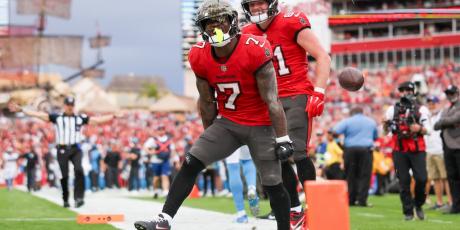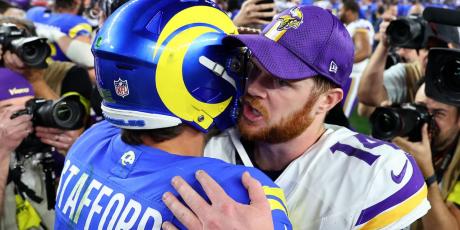Matt Ryan's Fantasy Impact on the Colts

On March 21, the Indianapolis Colts traded a third-round pick to the Atlanta Falcons in exchange for quarterback Matt Ryan. After 14 seasons as the Falcons’ starter, Ryan will replace recently traded Carson Wentz as the signal-caller for the Colts. The fantasy impact for Indianapolis will largely depend on whether the Colts tailor an offense for Ryan or Ryan adjusts to Indy’s method. In Atlanta, Ryan typically operated a pass-first offense while the Colts slanted more towards the run in 2021.
Click here for more 2022 Player Profiles!
The Evolution of Matt Ryan
After being drafted third overall in the 2008 Draft, Ryan’s career got off to a successful, albeit modest start, never throwing for at least 30 touchdowns in a season in his first four years and barely scratching the fantasy QB1 surface. In 2011, Atlanta brought in Dirk Koetter as their offensive coordinator. That hire would kick off an era where Ryan led one of the most pass-heavy offenses in the league over the last decade and change.
| Year | Team | Pass % in Neutral Game Script | Rank |
|---|---|---|---|
| 2008 | ATL | 45.4% | 30 |
| 2009 | ATL | 56.1% | 14 |
| 2010 | ATL | 55.6% | 12 |
| 2011 | ATL | 54.1% | 18 |
| 2012 | ATL | 64.1% | 1 |
| 2013 | ATL | 64.6% | 2 |
| 2014 | ATL | 63.6% | 1 |
| 2015 | ATL | 59.3% | 13 |
| 2016 | ATL | 60.5% | 8 |
| 2017 | ATL | 54.8% | 19 |
| 2018 | ATL | 64.0% | 5 |
| 2019 | ATL | 64.3% | 3 |
| 2020 | ATL | 62.3% | 4 |
| 2021 | ATL | 59.2% | 13 |
| AVG | 59.1% | 10 |
Whether it was Koetter, Kyle Shannahan, or Steve Sarkisian on the headset, the Falcons have let Ryan chuck the rock mostly at will. That approach, however, has resulted in one of the most volatile year-to-year fantasy quarterbacks in recent history. While Ryan has finished as a QB1 in terms of fantasy points per game six times since 2012—with four top-seven finishes and a pair of top-three seasons—he’s also had four campaigns where he hasn’t even been a high-end QB2, including a QB26 finish in 2021.
| Year | Age | G | GS | Cmp | Att | Cmp% | Yds | TD | TD% | Int | Int% | Y/A | AY/A | Y/G | FP/G | Rank |
|---|---|---|---|---|---|---|---|---|---|---|---|---|---|---|---|---|
| 2008 | 23 | 16 | 16 | 265 | 434 | 61.1 | 3440 | 16 | 3.7 | 11 | 2.5 | 7.9 | 7.5 | 215.0 | 12.8 | 19 |
| 2009 | 24 | 14 | 14 | 263 | 451 | 58.3 | 2916 | 22 | 4.9 | 14 | 3.1 | 6.5 | 6.0 | 208.3 | 14.1 | 18 |
| 2010 | 25 | 16 | 16 | 357 | 571 | 62.5 | 3705 | 28 | 4.9 | 9 | 1.6 | 6.5 | 6.8 | 231.6 | 16.1 | 12 |
| 2011 | 26 | 16 | 16 | 347 | 566 | 61.3 | 4177 | 29 | 5.1 | 12 | 2.1 | 7.4 | 7.5 | 261.1 | 17.8 | 9 |
| 2012 | 27 | 16 | 16 | 422 | 615 | 68.6 | 4719 | 32 | 5.2 | 14 | 2.3 | 7.7 | 7.7 | 294.9 | 19.9 | 7 |
| 2013 | 28 | 16 | 16 | 439 | 651 | 67.4 | 4515 | 26 | 4.0 | 17 | 2.6 | 6.9 | 6.6 | 282.2 | 16.6 | 18 |
| 2014 | 29 | 16 | 16 | 415 | 628 | 66.1 | 4694 | 28 | 4.5 | 14 | 2.2 | 7.5 | 7.4 | 293.4 | 18.5 | 7 |
| 2015 | 30 | 16 | 16 | 407 | 614 | 66.3 | 4591 | 21 | 3.4 | 16 | 2.6 | 7.5 | 7.0 | 286.9 | 15.5 | 26 |
| 2016 | 31 | 16 | 16 | 373 | 534 | 69.9 | 4944 | 38 | 7.1 | 7 | 1.3 | 9.3 | 10.1 | 309.0 | 22.0 | 2 |
| 2017 | 32 | 16 | 16 | 342 | 529 | 64.7 | 4095 | 20 | 3.8 | 12 | 2.3 | 7.7 | 7.5 | 255.9 | 15.0 | 19 |
| 2018 | 33 | 16 | 16 | 422 | 608 | 69.4 | 4924 | 35 | 5.8 | 7 | 1.2 | 8.1 | 8.7 | 307.8 | 21.9 | 3 |
| 2019 | 34 | 15 | 15 | 408 | 616 | 66.2 | 4466 | 26 | 4.2 | 14 | 2.3 | 7.3 | 7.1 | 297.7 | 18.6 | 10 |
| 2020 | 35 | 16 | 16 | 407 | 626 | 65.0 | 4581 | 26 | 4.2 | 11 | 1.8 | 7.3 | 7.4 | 286.3 | 18.3 | 12 |
| 2021 | 36 | 17 | 17 | 375 | 560 | 67.0 | 3968 | 20 | 3.6 | 12 | 2.1 | 7.1 | 6.8 | 233.4 | 13.7 | 26 |
Although Ryan’s individual results have been a roller coaster, one constant in Ryan’s career has been his ability to support high-end fantasy wide receivers and tight ends.
How Matt Ryan’s Pass-Catchers Have Fared in Fantasy
Since Ryan’s rookie season, three individual wide receivers have combined for 14 half-PPR WR1 fantasy campaigns with eight instances of a receiver finishing in the top six at his position with Ryan as their quarterback. Additionally, Ryan has helped orchestrate eight TE1 seasons which include five top-six finishes and a pair of top-three seasons.
| Player | Year | Pos | G | GS | Tgts | Tgts/G | Rec | Yds | TD | .5 PPR | .5 PPR/G | .5 PPR/G Rank |
|---|---|---|---|---|---|---|---|---|---|---|---|---|
| Julio Jones | 2015 | WR | 16 | 16 | 203 | 12.7 | 136 | 1871 | 8 | 307.1 | 19.2 | 2 |
| Roddy White | 2010 | WR | 16 | 16 | 179 | 11.2 | 115 | 1389 | 10 | 258.7 | 16.2 | 3 |
| Calvin Ridley | 2020 | WR | 15 | 15 | 143 | 9.5 | 90 | 1374 | 9 | 236.5 | 15.8 | 4 |
| Julio Jones | 2019 | WR | 15 | 15 | 157 | 10.5 | 99 | 1394 | 6 | 224.6 | 15.0 | 4 |
| Julio Jones | 2016 | WR | 14 | 14 | 129 | 9.2 | 83 | 1409 | 6 | 218.4 | 15.6 | 4 |
| Julio Jones | 2018 | WR | 16 | 16 | 170 | 10.6 | 113 | 1677 | 8 | 269.4 | 16.8 | 5 |
| Julio Jones | 2017 | WR | 16 | 16 | 148 | 9.3 | 88 | 1444 | 3 | 207.9 | 13.0 | 6 |
| Julio Jones | 2014 | WR | 15 | 15 | 163 | 10.9 | 104 | 1593 | 6 | 245.4 | 16.4 | 6 |
| Roddy White | 2011 | WR | 16 | 16 | 180 | 11.3 | 100 | 1296 | 8 | 227.6 | 14.2 | 7 |
| Roddy White | 2008 | WR | 16 | 15 | 148 | 9.3 | 88 | 1382 | 7 | 220.6 | 13.8 | 8 |
| Roddy White | 2009 | WR | 16 | 16 | 165 | 10.3 | 85 | 1153 | 11 | 224.0 | 14.0 | 9 |
| Roddy White | 2012 | WR | 16 | 15 | 142 | 8.9 | 92 | 1351 | 7 | 223.1 | 13.9 | 11 |
| Julio Jones | 2011 | WR | 13 | 13 | 95 | 7.3 | 54 | 959 | 8 | 174.5 | 13.4 | 11 |
| Julio Jones | 2012 | WR | 16 | 15 | 128 | 8.0 | 79 | 1198 | 10 | 222.3 | 13.9 | 12 |
| Julio Jones | 2020 | WR | 9 | 9 | 68 | 7.6 | 51 | 771 | 3 | 120.6 | 13.4 | 13 |
| Calvin Ridley | 2019 | WR | 13 | 10 | 93 | 7.2 | 63 | 866 | 7 | 165.5 | 12.7 | 16 |
| Roddy White | 2014 | WR | 14 | 14 | 125 | 8.9 | 80 | 921 | 7 | 172.1 | 12.3 | 17 |
| Calvin Ridley | 2018 | WR | 16 | 5 | 92 | 5.8 | 64 | 821 | 10 | 174.8 | 10.9 | 26 |
| Calvin Ridley | 2021 | WR | 5 | 5 | 52 | 10.4 | 31 | 281 | 2 | 55.6 | 11.1 | 29 |
| Harry Douglas | 2013 | WR | 16 | 11 | 132 | 8.3 | 85 | 1067 | 2 | 157.2 | 9.8 | 31 |
| Mohamed Sanu | 2017 | WR | 15 | 15 | 96 | 6.4 | 67 | 703 | 5 | 140.8 | 9.4 | 32 |
| Roddy White | 2013 | WR | 13 | 13 | 97 | 7.5 | 63 | 711 | 3 | 118.6 | 9.1 | 36 |
| Tony Gonzalez | 2012 | TE | 16 | 16 | 124 | 7.8 | 93 | 930 | 8 | 187.5 | 11.7 | 3 |
| Austin Hooper | 2019 | TE | 13 | 10 | 97 | 7.5 | 75 | 787 | 6 | 152.2 | 11.7 | 3 |
| Tony Gonzalez | 2009 | TE | 16 | 16 | 134 | 8.4 | 83 | 867 | 6 | 164.2 | 10.3 | 5 |
| Tony Gonzalez | 2011 | TE | 16 | 16 | 116 | 7.3 | 80 | 875 | 7 | 169.5 | 10.6 | 5 |
| Tony Gonzalez | 2010 | TE | 16 | 16 | 108 | 6.8 | 70 | 656 | 6 | 136.6 | 8.5 | 6 |
| Tony Gonzalez | 2013 | TE | 16 | 16 | 121 | 7.6 | 83 | 859 | 8 | 173.7 | 10.9 | 7 |
| Austin Hooper | 2018 | TE | 16 | 7 | 88 | 5.5 | 71 | 660 | 4 | 125.5 | 7.8 | 9 |
| Kyle Pitts | 2021 | TE | 17 | 15 | 110 | 6.5 | 68 | 1026 | 1 | 142.6 | 8.4 | 12 |
Of course, having talent such as Roddy White, Julio Jones, and Tony Gonzalez to throw to helps but Ryan’s ability to drop back and throw it 600 times per season has helped his supporting cast as well. In addition to a multitude of plug-and-play fantasy players that have caught passes from Ryan, Atlanta has produced another eight receivers that finished as WR3s or better in fantasy. Given his history as a high-volume passer, it’s been reasonable for Ryan to have as many as three fantasy-relevant pass-catchers at almost any point in his career.
How Matt Ryan’s Past Translates to the Colts’ Present
There are a couple of red flags that suggest Ryan won’t be as pass-happy in Indianapolis as he was in Atlanta.
One primary concern is that Ryan’s efficiency has consistently waned in recent years and that finally resulted in a drop in volume in 2021, albeit with a new playcaller. After peaking at 10.1 adjusted yards per attempt in 2016, that metric steadily declined to sub-7.0 last season for just the fourth time in Ryan’s career and the first time since 2013. Even with the 17th game added to the schedule in 2021, Ryan threw fewer than 600 times for the first time in four seasons.
In terms of efficiency and volume, Ryan’s 2021 was actually quite similar to what Wentz produced for the Colts last season. With Wentz, Indianapolis ranked in the top half of the league in rushing rate in neutral game script, while finishing last in neutral pace. Given Ryan’s age and his recent dip in production along with a limited pass-catching corps in Indy, it seems much more likely that Frank Reich leans heavily on his star running back than try and recreate the passing attacks that Ryan led in the mid-to-late 2010s.
This isn’t to say that Ryan and the Colts won’t offer each other some mutual benefits. Ryan gets a slight upgrade in protection (Colts ranked 13th in adjusted sack rate allowed last season; Falcons ranked 20th) and should see more positive game script in 2022 on a team with divisional title aspirations. Although Ryan’s efficiency has decreased in recent seasons, he still offers a potential upgrade over Wentz in terms of accuracy—Ryan ranked seventh in on-target rate last season (SportsInfoSolutions), compared to 25th for Wentz with both posting similar average throw depths.
The biggest beneficiary of Ryan’s arrival figures to be Michael Pittman Jr. The second-year receiver broke out in 2021 with a half-PPR WR19 finish but his volume was erratic. Pittman had five games with double-digit targets but also had six contests where he was thrown at five or fewer times. With Ryan’s history of zeroing in on his favorite receiver(s)—Ryan has targeted a specific player on at least 25% of passes in a season 11 times—it’s reasonable to expect Pittman to maintain the 26% target share that he saw last year, but with more consistency on a game-to-game basis. If Ryan can at least maintain his accuracy, Pittman has high-end WR2 upside and should easily settle in as a fantasy starter in all formats.
The Bottom Line
- Matt Ryan has historically thrown at one of the highest rates in the league but has struggled to maintain high-level efficiency on a year-to-year basis.
- Ryan’s recent dip in production combined with a move to one of the best rushing teams in the league suggests Ryan will throw as little as he did in 2021, and maybe even less.
- Ryan is undraftable in traditional redraft formats and will be unappealing as a streamer except in the absolute best matchups since he offers no rushing upside. In best ball, Ryan is a low-upside QB2/QB3 but does offer stability as a likely every-week starter. As with most late-round best ball quarterbacks, he is best utilized when drafted to complete a team stack.
- With the offense likely still running through Jonathan Taylor, Ryan’s arrival does nothing to drop Taylor’s value as a high-end first-round fantasy pick.
- Michael Pittman Jr. was in trouble of seeing his stock tumble if Indianapolis brought in an incapable quarterback. Ryan’s history of supporting top-tier fantasy pass-catchers gives Pittman some built-in upside on his current WR27 ADP. Improving on his WR19 finish from last season is well within Pittman’s range of outcomes and his target volume on a game-to-game basis should be more consistent than it was in 2021.



















